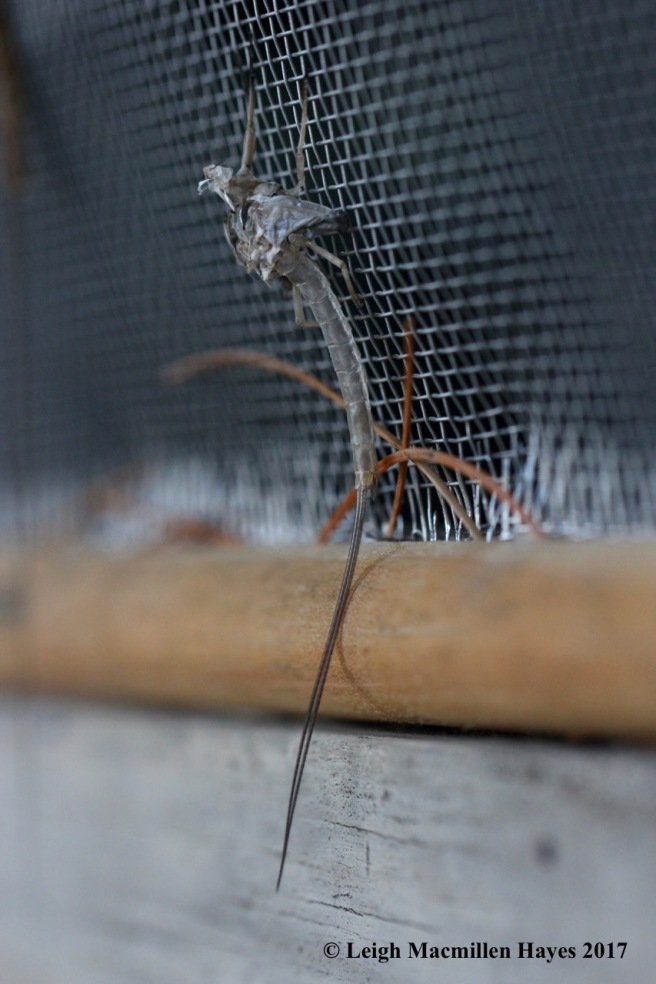
I used to think mayflies emerged only in May.
Maybe I’ve seen them in other months, but I’d never really thought about it. Yesterday this mayfly greeted me in the morning. And in the evening, it was still there. So my May-only theory proved to be wrong.

I used to think they had only one adult form.

That all changed this morning when I spotted it again. Only, I also spotted something else an inch or two away. An exoskeleton or exuvia? From a mayfly? It certainly looked mayfly-like with the same narrow and segmented body plus long-tail cerci.

When I looked more closely, I realized that the exuvia was about half the size of the true adult form. As for that cloudy-winged specimen I’d spied yesterday–it had been a teenager, aka a subimago. I let the wings trick me because I didn’t know better. Though it looked adult-like, it wasn’t sexually mature yet.
Mayflies are unique in that after the nymph emerges from the water as the subimago (that fishermen call a dun) like yesterday’s model, they seek shelter before shedding their skin for the final transformation. How lucky for me that this dun chose our porch screen on which to rest.

And so, I was gifted a second opportunity to look. It can take a few minutes to two days before a subimago transforms into a clear-winged imago or spinner, though the actual metamorphosis is quick. I wish I’d seen it, but at least I got to see the end result.

I’m not sure my friend appreciated it, but I was glad for our opportunity to spend some time up close and personal.

While in an aquatic form for a year or two, it had done plenty of eating. But as an adult, eating became a thing of its past as it had no functional mouth parts.

It did have plenty of eyes, however. The better to find food when immature and later a mate, I suppose. Like other flies, its two outer eyes were large and compound. Between them were three simple eyes (ocelli).

The two pairs of triangular wings were held upright like a damselfly, rather than flat like a dragonfly. When I compared yesterday’s opague wings with today’s, the clarity of the new wings defined by dark veins seemed an obvious difference and one I’ll need to pay attention to going forth.

Male or female? That was the question, but only for a moment. Do you see the aedeagi or penis-like appendages at the tip of the abdomen and below the two cerci (tail-like appendages)? Meet Mr. Mayfly.

I know that because mayflies emerge in swarms, they can be a nuisance. But this was only one. And our friendship only lasted for a few hours total–though he spent about 24 hours in the same spot. By noontime he had disappeared–of his own efforts I hope . . . heading off to do some courting. His days are numbered, I know, for his main function is to mate and maybe mate again, before he dies.
But today he served another function as he taught me a lesson. My best learning comes from observation . . . and realizing that what I used to think isn’t always accurate.
My thanks to a mayfly.

Oh. Wow. I couldn’t wait to see this. How exciting for you! Great pics!
LikeLiked by 1 person
You just had a feeling . . . and you were right!
LikeLike
Such great close up images. Thanks for such a beautiful post.
LikeLiked by 1 person
And thank you for stopping by to take a look.
LikeLike
It must be something in the air… a month ago, in England, I went through the same process of astonished discovery about the life cycle of the mayfly, and photographed the two different winged phases. Extraordinary really that the same insect is found on both sides of the Atlantic.
Moira
LikeLike
So thankful for that we can continue to learn, Moira, on both sides of the pond. See you SOON!
LikeLike